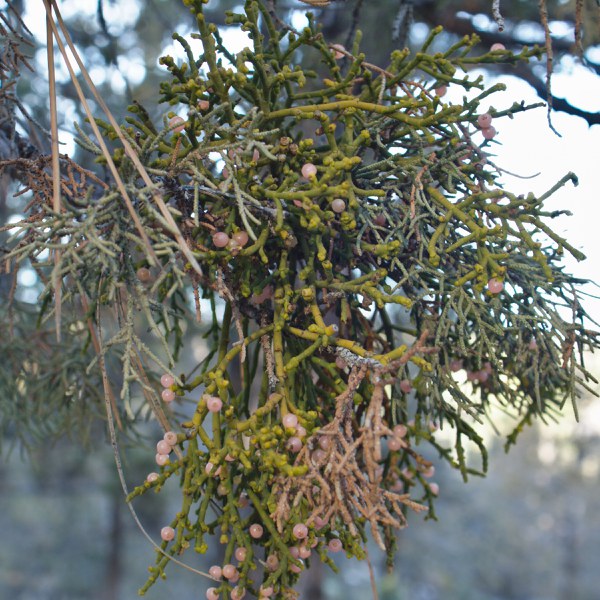We see it in doorways every year: a leafy green plant with small white berries. Depending on who we are or who we’re with, we may try to linger or do the opposite and avoid pausing beneath it!
Long associated with fertility and long-life, mistletoe seems to have been part of various rituals or traditions through the Middle Ages, perhaps with Greek, Norse, or Celtic origins. But it wasn’t until the end of the 18th century – in 1784 – that mistletoe was first recorded as part of Christmas celebrations and associated with the kissing tradition we know today. One of its enduring mysteries is how mistletoe jumped from magical potions and medicines to Christmas kisses, but we do know it was considered bad luck to turn down a smooch!
Phoradendron leucarpum, or American mistletoe, which we hang in our homes at the holidays, is only one kind of more than 1,300 species! The genus Arceuthobium includes the other type of mistletoe native to North America, dwarf mistletoes, twiggy flowering plants found in conifers.
Rather than being a specific type of plant, mistletoes have evolved in five separate plant families and are identified by their lifecycle. All mistletoes are parasitic woody plants that grow above ground on other plants. Mistletoes grow on every continent except Antarctica, and in a variety of environments. Most have a favorite type of host plant and won’t cross from one host species to another.
Mistletoes do reduce the lifespan of their host trees, but it isn’t as simple as saying this is a good or bad thing. Conserving and, when necessary, restoring a diversity of different plant species is critical to the health of our forests, and too much mistletoe—like too much of anything—can cause problems.
The name mistletoe comes from Anglo-Saxon words for “bird droppings on twigs,” which is how many of these plants propagate. There are around 90 species of birds that are mistletoe specialists, meaning they primarily eat mistletoe berries, including species of flycatchers, grosbeaks, grouse, mourning doves, bluebirds, robins, and pigeons. After a bird eats a berry, the mistletoe seed is glued into a host tree by an extra-sticky substance called viscin. Dwarf mistletoes rely less on animals to spread their seeds, but use hydrostatic pressure to explode their berries and send seeds flying up to 50 miles per hour as far as 32 feet away!

Mistletoes are not true parasites, but are called hemi-parasites, because most are leafy plants that photosynthesize some of their own food. Scientists are still uncovering the exact mechanisms of how mistletoes work, but we do know that they develop a sort of straw called a haustorium that is used to draw additional nutrients from the host tree.
Archaeological and fossil records indicate that mistletoes have been part of our ecosystems for millions of years, and ecologists now believe they are an essential part of a healthy forest. They provide food and shelter for a wide range of animals, from insects to elk! Research has found that removing mistletoe from a forest results in a dramatic decrease in bird populations. By reducing host tree lifespans, mistletoes also create more snags, which are standing dead or dying trees, and increase available sights for cavity nesters to raise their young. Research by the USGS found that 64% of Cooper’s hawk nests in northeast Oregon were in mistletoe brooms. Mistletoe brooms are created when mistletoe grows into thick overlapping masses of misshapen stems, which are also often called “witch’s brooms.”
Larger animals such as deer and elk also use trees with large brooms as resting sites and will eat mistletoe during winter months. In addition, mistletoe leaf litter has been found to significantly increase the fertility of the surrounding soil!
Mistletoes, though parasitic, are not an infection or disease in a forest. It can take 70 years for mistletoes to spread over just 1.5 acres, and they provide many beneficial exchanges for the nutrients they consume. More than 20 mistletoe species worldwide are currently considered endangered. When collecting a few plants to decorate indoors this season, remember that they should be valued year-round for the important role they play in forest health.
Learn more:
- Mistletoe in Oregon: Forest Robber or Robin Hood? by Mike Vernon - The Corvallis Advocate
- Birds of Camp Polk Meadow Preserve
- Ugly Beautiful: How dead trees are bringing life to our forests
- Creating Snags as Part of Metolius Preserve Forest Restoration
Sources:
- Mistletoe | Plant, Poison, Major Species, & Christmas, Britannica
- The Biology of Mistletoe, Smithsonian
- Not Just for Kissing: Mistletoe and Birds, Bees, and Other Beasts, U.S. Geological Survey
- Mistletoe's effects on trees vary by type, OSU Extension Service
- Dwarf Mistletoes, USDA Forest Service
- Why We Kiss Under the Mistletoe During Christmas, TIME


